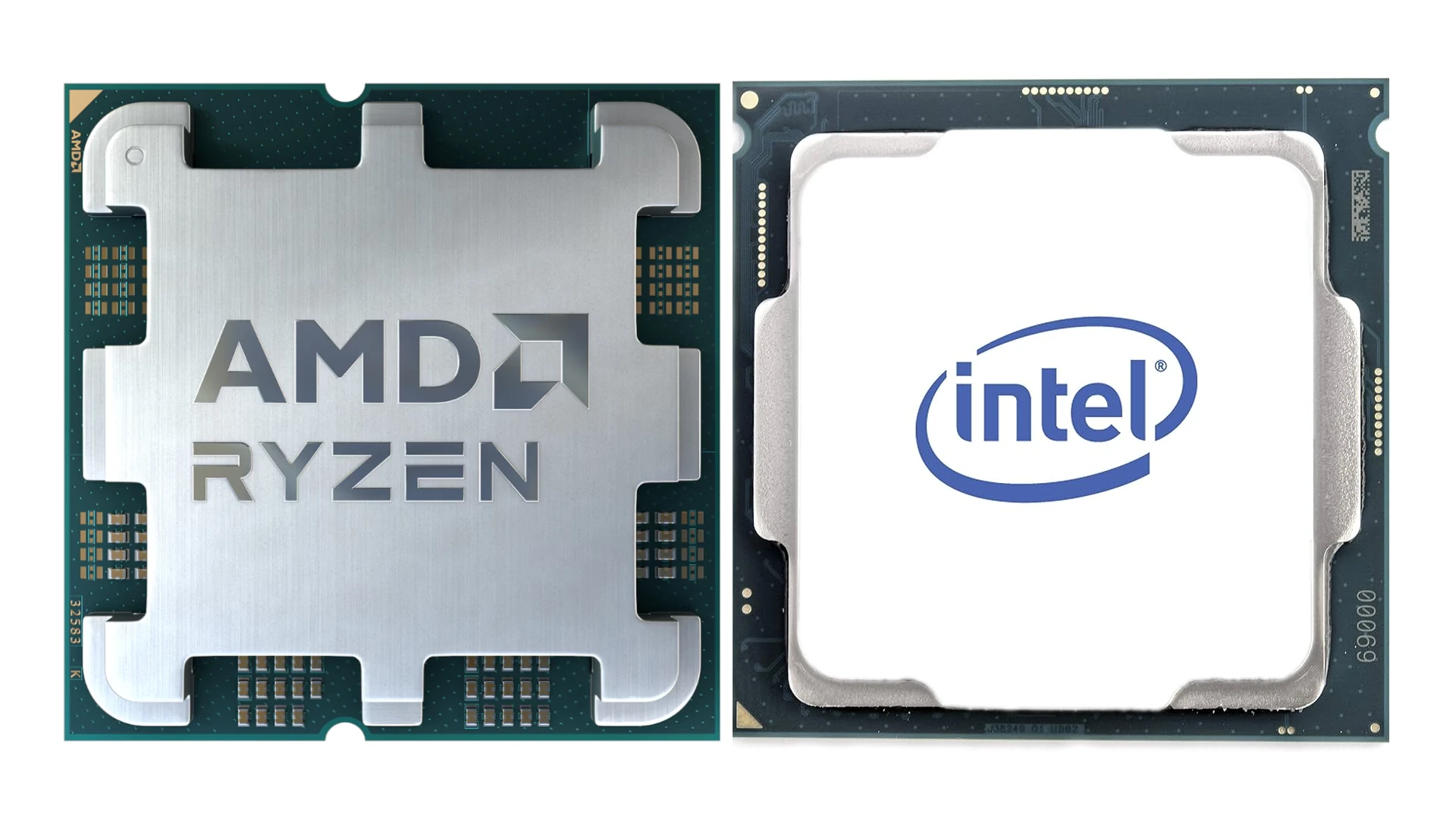AMD’s rise in the CPU market has shifted from a comeback narrative to a full-blown challenge against Intel’s long-standing dominance. As of early 2025, AMD has made aggressive strides across nearly all segments—desktop, server, and even mobile. While Intel still commands the lion’s share of the x86 market overall, AMD’s strategic product roadmap, particularly in the Ryzen and EPYC lines, is reshaping the industry landscape.
Let’s break down how AMD’s performance stacks up and why its recent momentum matters.
A Snapshot of AMD vs. Intel – Early 2025 Market Share
| Segment | AMD Market Share (Q4 2024 / Q1 2025) | Intel Market Share (Q4 2024 / Q1 2025) | Notes |
|---|---|---|---|
| Overall x86 CPU | 24.7% | 75.3% | AMD up 4.3% YoY |
| Desktop CPUs | 27.1% (units), 27.3% (revenue) | ~72.9% | AMD gained 7.4% YoY |
| Laptop CPUs | 23.7% | 73.6% | Intel still leads 3:1 |
| Server CPUs | 25.1% (units), 35.5% (revenue) | <75% | AMD outsold Intel in revenue |
| Gaming (Steam) | 38.73% | 61.27% | Based on December 2024 Steam Survey |
| Mindfactory (DE) | 92.16% | 7.84% | Reflects strong AMD retail loyalty |
| GPU (Global) | 17% | N/A | Nvidia remains dominant |
| GPU (Japan) | 45% (gaming segment) | N/A | Regional retail surge |
What’s Fueling AMD’s Momentum?
1. Strong Ryzen Desktop Performance
AMD’s Ryzen 7000 and 8000 series have solidified its reputation for exceptional multi-threaded performance, while efficiency improvements with 4nm and 5nm nodes (thanks to TSMC) helped boost competitiveness across price tiers. In the enthusiast DIY market, AMD’s value proposition—more cores per dollar—continues to sway consumers.
2. EPYC’s Data Center Dominance
In a significant milestone, AMD’s EPYC server chips have begun to outsell Intel’s Xeon line in revenue. The Genoa and Bergamo chips, in particular, gained traction with hyperscalers and AI workloads. AMD’s server revenue now accounts for 35.5% of the total server market, driven by performance-per-watt advantages and architectural innovations.
3. Gamers Shifting Toward AMD
AMD’s strong showing on the Steam Hardware Survey—nearing 40% CPU market share—reflects increasing adoption among gamers. This growth is partially fueled by budget-conscious builders and streamers who benefit from Ryzen’s higher core counts and better multitasking performance.
4. Competitive Pricing
AMD has undercut Intel in several segments, offering more threads and unlocked performance at similar or lower price points. This strategy has earned them consumer goodwill and retailer support, particularly in Europe and Asia.
⚠️ But There Are Headwinds
Despite AMD’s momentum, the competitive landscape is evolving fast. Intel is expected to launch its Lunar Lake chips later in 2025, with massive architectural overhauls focused on AI and integrated graphics. Analysts are anticipating aggressive pricing tactics from Intel, with potential CPU price cuts of 20–40%, aiming to regain consumer share—especially in laptops.
Additionally, AMD faces:
- Margin pressures, especially if it joins Intel in a price war.
- Geopolitical limitations in its AI GPU expansion into China.
- Tougher battles in mobile, where Intel’s efficiency improvements with Meteor Lake chips continue to shine in ultrabooks.
KeyBanc recently downgraded AMD stock in April 2025, citing these pressures, although investors still view the company’s long-term outlook as strong—particularly if its AI and GPU segments continue to mature.
What Comes Next?
- Zen 5 CPUs (Ryzen 9000 series) are expected to push AMD’s desktop and mobile lines further, with better IPC gains and power efficiency.
- EPYC Turin chips, based on Zen 5, will continue AMD’s assault on the data center space, aiming for further revenue share in AI and cloud compute.
- Intel’s response, particularly the Lunar Lake and Arrow Lake platforms, will be critical to watch as they integrate more AI accelerators and improved Xe graphics.
Bottom Line
AMD has entered 2025 with substantial momentum, especially in desktops and servers. While Intel retains dominance in mobile and overall x86 units, AMD is winning key battles in revenue share and enthusiast mindshare. The next phase of this silicon showdown will hinge on pricing strategies, AI integration, and efficiency gains in upcoming chip generations.
For now, AMD isn’t just catching up—it’s changing the rules of the game.
Key Takeaways
- AMD Ryzen generally offers better multi-core performance and power efficiency while Intel Core often leads in single-core speeds for specific gaming scenarios.
- Battery life tends to be superior in Ryzen-based laptops, making AMD a strong choice for portable computing needs.
- Your specific use case should determine your choice, with content creators benefiting from AMD’s multi-core strength and some gamers preferring Intel’s single-core advantages.
Architecture and Processing Power
AMD and Intel processors differ significantly in their architectural designs, impacting performance across various computing tasks. These differences affect everything from power efficiency to processing capabilities in both everyday and specialized applications.
Core and Thread Count
AMD Ryzen processors typically offer more cores and threads at similar price points compared to Intel counterparts. For example, the Ryzen 9 series features up to 16 cores and 32 threads, while Intel Core i9 processors in the same price range often provide 10-14 cores.
This core advantage gives AMD an edge in heavily multi-threaded applications like video rendering and 3D modeling. Ryzen 5 and Ryzen 7 processors similarly outpace Intel Core i5 and i7 in core counts at comparable price points.
Intel has responded with a hybrid architecture in newer generations, using a mix of Performance cores (P-cores) and Efficiency cores (E-cores). This design aims to balance processing power with energy efficiency.
For budget-conscious users, Ryzen 3 and Intel Core i3 processors offer fewer cores but remain capable for everyday tasks.
Clock Speeds and Overclocking Potential
Intel processors traditionally maintain higher base and boost clock speeds compared to AMD. Recent Intel Core i5 and i7 processors can reach boost frequencies of 5.0 GHz or higher.
AMD has narrowed this gap with their Ryzen 5000 and 7000 series, achieving comparable clock speeds while maintaining better power efficiency due to their advanced manufacturing processes (7nm and 5nm vs Intel’s larger 10nm process).
Both manufacturers offer overclocking capabilities in their unlocked processors:
- Intel designates these with a “K” suffix (like Core i7-12700K)
- AMD Ryzen processors are generally all unlockable
Overclocking potential varies by specific chip model and cooling solutions. Intel often has a slight edge in maximum achievable frequencies, but AMD processors typically run cooler and consume less power when pushed to their limits.
Single-Core and Multi-Core Performance
Intel processors have historically excelled in single-core performance, making them preferred for gaming and applications that don’t utilize multiple cores effectively. Recent benchmarks show Intel Core processors still holding a slight edge in single-threaded tasks.
AMD Ryzen processors dominate in multi-core workloads thanks to their higher core counts and efficient architecture. This makes Ryzen CPUs ideal for content creation, virtualization, and professional applications that can utilize multiple cores simultaneously.
The performance gap has narrowed significantly in recent generations. Intel’s 12th and 13th gen processors show improved multi-core performance, while AMD’s Ryzen 7000 series has enhanced single-core capabilities.
For most users, both high-end Intel Core i9 and AMD Ryzen 9 processors will provide excellent performance across all applications, with specific advantages depending on workload type.
Gaming and Content Creation Capabilities
Both AMD and Intel processors offer distinct advantages when it comes to gaming and content creation tasks. The choice between them often depends on specific use cases, budget constraints, and performance priorities.
Gaming Performance Evaluation
AMD’s Ryzen 7 9800X3D currently stands as the market’s fastest gaming CPU, outperforming even Intel’s more expensive options. This impressive gaming capability comes from AMD’s 3D V-Cache technology, which significantly improves game performance by reducing memory latency.
Intel processors traditionally held the gaming crown, with their higher single-core speeds giving them an edge in many games. However, the gap has narrowed significantly in recent generations.
For mainstream gamers, both the Ryzen 5 and Intel Core i5 series provide excellent performance at mid-range price points. The higher-end Ryzen 9 and Core i9 processors offer diminishing returns for gaming alone but shine when combined with streaming or other background tasks.
Multitasking and Professional Tasks
AMD Ryzen processors generally excel in multi-threaded workloads thanks to their higher core counts at similar price points. This makes them particularly strong for content creators working with video editing software, 3D rendering applications, and other professional tools.
Intel CPUs tend to perform better specifically in Adobe applications, which many professional creators rely on. Their QuickSync technology also provides hardware acceleration for video encoding and decoding tasks.
For serious content creation, the Ryzen 9 and Core i9 processors offer the best performance with their high core counts and threading capabilities. The Ryzen 7 and Core i7 provide an excellent middle ground for those who need strong content creation performance without the premium price.
3D rendering tasks typically favor AMD’s higher core count approach, while some specialized workloads may still benefit from Intel’s architecture.
Integrated Graphics and Discrete GPU Support
Intel has historically offered superior integrated graphics solutions, with their newer Iris Xe graphics providing decent performance for casual gaming and basic content creation. This can be valuable for budget builds or compact systems where a discrete GPU isn’t practical.
AMD’s integrated graphics in their APU lineup typically outperform equivalent Intel options for gaming but may lack some of the media encoding features found in Intel’s solutions.
Both platforms support the latest PCIe standards with Intel pushing ahead to PCIe 5.0 on their newest platforms, while AMD offers excellent PCIe 4.0 support. This affects how well each CPU works with high-end graphics cards and fast storage.
For serious gaming or content creation, a discrete GPU remains essential regardless of CPU choice. Both AMD and Intel processors pair well with modern graphics cards from NVIDIA or AMD.
Energy Efficiency and Thermal Performance
Power consumption and heat management are critical factors when choosing between AMD and Intel processors. These aspects directly impact electricity bills, system cooling needs, and overall performance sustainability.
Power Consumption and Efficiency
AMD processors, particularly the Ryzen series, have gained reputation for better power efficiency under heavy workloads. When CPUs run at 100% utilization for extended periods, AMD typically offers better performance-per-watt metrics. This advantage comes from AMD’s more advanced manufacturing processes.
However, Intel CPUs tend to consume less power during idle states. Search results indicate that Alder Lake processors use less than 10 watts at idle, making them more efficient when the computer is performing light tasks.
For users running demanding applications like video rendering or scientific calculations, AMD’s efficiency advantage becomes more significant. The power difference can impact electricity costs for systems that run constantly.
Efficiency comparison:
- AMD: Better efficiency at full load
- Intel: Better efficiency at idle/light loads
Battery Life and Mobility
For laptop users, battery life is a crucial consideration when choosing between AMD and Intel processors. Recent tests show Intel-powered laptops can provide longer battery life in some cases.
According to search results, Intel Framework 13 laptops lasted almost 2 hours longer than their AMD counterparts in battery tests. The AMD model ran for about 7 hours, while the Intel version approached 9 hours.
This difference matters significantly for mobile professionals who work away from power outlets. Intel’s edge in idle power consumption contributes to this battery life advantage in typical use scenarios that involve periods of low activity.
However, battery performance depends on many factors beyond just the CPU, including screen brightness, software optimization, and battery capacity.
Price Comparison and Market Segmentation
AMD and Intel compete aggressively on price while targeting different segments of the CPU market. Their pricing strategies directly impact consumer choices, with AMD typically offering more cores and performance per dollar compared to Intel’s premium positioning.
Competitive Pricing Strategies
AMD Ryzen processors have disrupted the CPU market with their value-oriented approach. The search results confirm that AMD offers more cores and cache for the same or lower price than comparable Intel products. This price advantage is particularly evident in mid-range and high-end segments.
For example, the Ryzen 7 5800X (priced around $300) outperforms Intel’s Core i7-11700K (approximately $470) while offering two additional cores. This represents a significant value proposition for consumers who prioritize multi-threaded performance.
Intel typically commands premium prices, especially for their flagship Core i9 models like the i9-12900K. The company relies on brand recognition and slightly better single-core performance in certain applications to justify higher prices.
Product Offering Across Various Segments
Both companies maintain comprehensive product stacks targeting different market segments:
Entry-Level Segment:
- AMD Ryzen 3 processors compete directly with Intel Core i3 chips
- Both target budget-conscious consumers
- AMD typically offers better multi-threading capabilities at this price point
Mid-Range Segment:
- Ryzen 5 series (like the 7600X) competes with Intel Core i5 processors
- This segment represents the sweet spot for most gamers and productivity users
- Price differences of $50-100 often exist between comparable models
High-End Segment:
- AMD Ryzen 7 and 9 processors compete with Intel Core i7 (like the 12700K) and i9 chips
- Intel maintains stronger market presence in premium segments despite AMD’s value advantage
- Recent benchmarks show Intel’s Core Ultra 9 285K outperforming AMD’s Ryzen 9 9950X in most tests
Market share remains heavily tilted in Intel’s favor, with Intel holding approximately 82% of CPU market share compared to AMD’s 17%, despite AMD’s price advantages.
Frequently Asked Questions
The debate between AMD Ryzen and Intel processors covers many aspects from gaming performance to power efficiency. These common questions help clarify key differences between the two major CPU manufacturers.
What are the performance differences between AMD Ryzen and Intel processors for gaming?
Intel processors traditionally held an edge in gaming due to their higher single-core performance. This advantage has narrowed significantly in recent generations.
AMD Ryzen processors excel at multi-threaded performance, making them competitive in modern games that utilize multiple cores. According to search results, Intel still maintains a slight advantage in gaming-specific tasks.
Current benchmarks suggest the gaming performance gap is small enough that other factors like price and overall system balance may be more important for most gamers.
How does the power efficiency compare between AMD Ryzen and Intel CPUs?
AMD Ryzen processors generally offer better power efficiency compared to Intel’s recent generations. This translates to less heat production and lower energy consumption.
Intel’s 14th generation processors in particular run hotter than comparable AMD options. Better power efficiency in AMD chips often means quieter cooling solutions are possible.
The improved efficiency of Ryzen processors can be particularly beneficial in compact builds where thermal management is challenging.
Which processor brand generally offers better value for everyday computing, AMD Ryzen or Intel?
AMD Ryzen processors typically offer more cores and threads at similar price points compared to Intel options. This makes them excellent value for everyday computing tasks.
For basic productivity work, web browsing, and office applications, both brands perform well. The value equation often favors AMD when considering performance-per-dollar.
Budget-conscious buyers might benefit more from AMD’s offerings, while specific workloads may justify Intel’s premium in certain cases.
In terms of compatibility with motherboards, what should be considered when choosing between AMD Ryzen and Intel?
AMD has maintained better socket compatibility across multiple CPU generations compared to Intel. This means upgrading to a newer AMD processor often doesn’t require a motherboard replacement.
Intel typically changes socket designs more frequently, which can increase the total cost of upgrades. Both platforms require checking specific motherboard chipset compatibility.
AMD’s AM4 platform supported multiple generations, while the newer AM5 has promises of similar long-term support. Intel’s frequent socket changes can increase long-term costs.
How do AMD Ryzen and Intel processors differ in terms of multitasking and core count?
AMD Ryzen processors generally offer higher core and thread counts at comparable price points. This provides superior multitasking capabilities and better performance in heavily threaded applications.
Content creators, video editors, and 3D artists often benefit from AMD’s multi-threaded advantage. Search results indicate AMD can be up to 9% more powerful in multi-threaded workloads.
Intel processors still perform well in multitasking but typically require spending more to match the core count of equivalent AMD options.
What are the thermal characteristics to expect when comparing AMD Ryzen and Intel CPUs?
AMD Ryzen processors typically run cooler than comparable Intel CPUs, especially when compared to Intel’s 14th generation. This thermal efficiency means less robust cooling solutions may be needed.
Intel processors, particularly their high-performance models, can generate significant heat under load. This may require more substantial cooling solutions to maintain optimal performance.
The cooler operation of AMD processors can contribute to system longevity and stability over time. Some users report AMD systems being more reliable due to these thermal characteristics.






